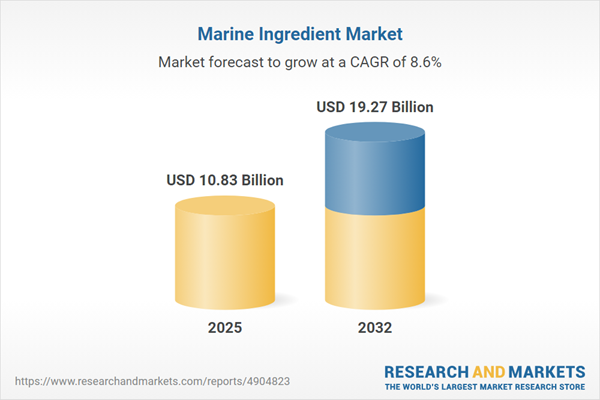Speak directly to the analyst to clarify any post sales queries you may have.
The marine ingredient market is undergoing significant transformation, propelled by evolving sustainability requirements, emerging production technologies, and increasing regulatory complexity. Senior decision-makers need focused intelligence to adapt quickly and capture opportunities as operational landscapes shift.
Marine Ingredient Market Snapshot
The global marine ingredient market was valued at USD 9.96 billion in 2024, with projected growth to USD 10.83 billion by 2025 and long-term potential reaching USD 19.27 billion by 2032. Growth is driven by the rising demand for functional nutrition, increased aquaculture production, and renewed emphasis on supply chain resilience. Organizations are now focusing on scenario modeling and enhancing their ability to adjust strategies, maintaining readiness for regulatory shifts. Executive teams that successfully integrate their operational resources with global market developments are positioned to achieve a sustainable advantage in this evolving sector.
Marine Ingredient Market: Scope & Segmentation
This analysis provides in-depth segmentation and specialized frameworks to support executive-level decisions throughout the marine ingredient supply chain:
- Product Types: Algal oils (including DHA, EPA, blends), chitosan, fish meal, fish oils, krill oil, marine collagens, and marine peptides. These options address both established markets and emerging product categories, facilitating wide-ranging applications.
- Source Variants: Sourcing covers microalgae, macroalgae, krill, shrimp, various fish species (such as anchovy, menhaden, sardine), and mollusks (including mussels, oysters, squid). Each variant supports corporate sustainability and enhances end-to-end traceability for transparent supply chain reporting.
- Form Options: Marketed in capsules, oils, powders, pellets, and tablets, enabling manufacturers to tailor offerings for diverse industry requirements and end-user preferences.
- Applications: Serving animal feed, aquaculture, pet food, poultry, ruminant nutrition, cosmetics, dietary supplements, food and beverages, and pharmaceuticals. This breadth supports targeted innovation within specific high-growth sectors.
- Regional Segments: Market trends are tracked in the Americas, EMEA, and Asia-Pacific to guide region-specific strategies, compliance measures, and the identification of growth opportunities within global supply networks.
- Leading Companies Analyzed: The report benchmarks industry leaders such as COPEINCA S.A., Austral Group S.A., Pesquera Diamante S.A., Omega Protein Corporation, Aker BioMarine ASA, Cargill Incorporated, Royal DSM N.V., BASF SE, Croda International plc, and KD Pharma Group, offering valuable context for competitive positioning and future planning.
This comprehensive segmentation enables organization leaders to optimize investments, evolve operational models, and maintain regulatory alignment amid sector changes.
Key Takeaways for Senior Decision-Makers
- Advanced extraction techniques, including enzymatic and fermentation processes, expand the market’s potential by supporting product innovation and increasing differentiation, especially in nutrition and specialty pharmaceutical applications.
- Resource-efficient manufacturing and transparent supply chains are key to operational resilience and demonstrable sustainability, building stakeholder trust and responding to increasing scrutiny from both buyers and regulators.
- Digital tracking and documentation technologies strengthen compliance and product traceability, supporting superior transparency and efficient regulatory reporting in complex B2B contexts.
- Agile operational models ensure companies can preempt regulatory modifications and regional shifts, reducing the risk of compliance disruptions and supporting smooth international operations.
- Improved formulation capabilities help firms achieve stringent client requirements and access niche markets where quality differentiation is a principal buying criterion.
These strategies enable leaders to reinforce their resilience, efficiently navigate ongoing regulatory changes, and exploit growth avenues as the sector undergoes transformation.
Tariff Impact on Marine Ingredient Supply Chains
Recent tariff adjustments in the United States require companies to reassess supplier relationships and refocus efforts on robust cost management. Approaches such as shifting to local production or partnering with nearby vendors are increasingly prioritized for mitigating pricing volatility. Diversifying suppliers and maintaining adaptable sourcing policies now form the core of contingency planning as tariff landscapes continue to evolve globally.
Methodology & Data Sources
This report draws on comprehensive regulatory analyses, systematic patent reviews, senior executive interviews, and targeted sector surveys. This robust methodology ensures findings account for sector-specific realities and the practical needs of the pharmaceuticals, animal health, nutrition, and cosmetics verticals.
Why This Report Matters
- Delivers segmented and actionable insights to support the development of robust, long-term market plans tailored specifically to the marine ingredient industry.
- Prepares executive teams to manage regulatory challenges, react effectively to tariff shifts, and address the complexities of global supply chain management with greater confidence.
- Supports the pursuit of innovation, sustainable sourcing, and operational resilience as market expectations and production technologies continue to shift.
Conclusion
This research equips executive leadership with the clarity needed to adopt new technologies, maintain compliance, and plan for strategic growth. Organizations are better positioned to achieve lasting success and demonstrate readiness in a rapidly evolving market environment.
Additional Product Information:
- Purchase of this report includes 1 year online access with quarterly updates.
- This report can be updated on request. Please contact our Customer Experience team using the Ask a Question widget on our website.
Table of Contents
3. Executive Summary
4. Market Overview
7. Cumulative Impact of Artificial Intelligence 2025
Companies Mentioned
The companies profiled in this Marine Ingredient market report include:- COPEINCA S.A.
- Austral Group S.A.
- Pesquera Diamante S.A.
- Omega Protein Corporation
- Aker BioMarine ASA
- Cargill, Incorporated
- Royal DSM N.V.
- BASF SE
- Croda International PLC
- KD Pharma Group
Table Information
| Report Attribute | Details |
|---|---|
| No. of Pages | 192 |
| Published | November 2025 |
| Forecast Period | 2025 - 2032 |
| Estimated Market Value ( USD | $ 10.83 Billion |
| Forecasted Market Value ( USD | $ 19.27 Billion |
| Compound Annual Growth Rate | 8.5% |
| Regions Covered | Global |
| No. of Companies Mentioned | 11 |









